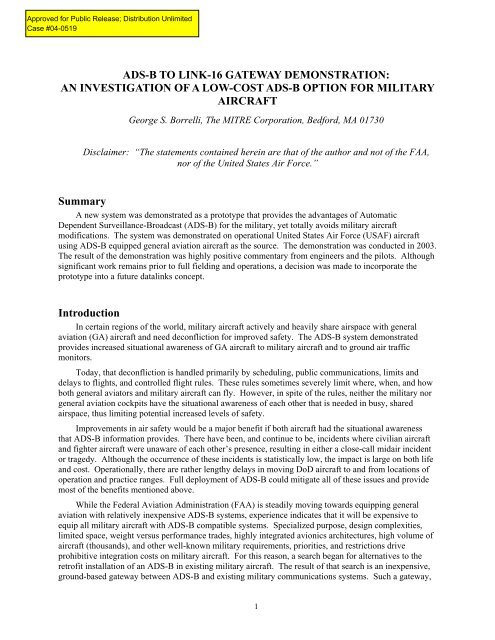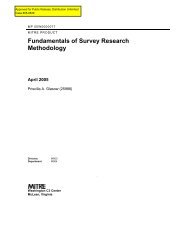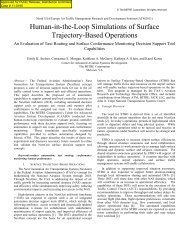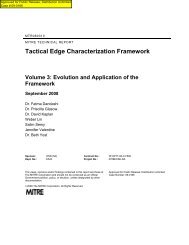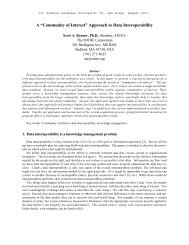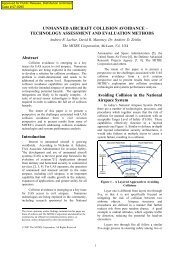ADS-B to Link-16 Gateway Demonstration: An Investigation of ... - Mitre
ADS-B to Link-16 Gateway Demonstration: An Investigation of ... - Mitre
ADS-B to Link-16 Gateway Demonstration: An Investigation of ... - Mitre
Create successful ePaper yourself
Turn your PDF publications into a flip-book with our unique Google optimized e-Paper software.
<strong>ADS</strong>-B TO LINK-<strong>16</strong> GATEWAY DEMONSTRATION:<br />
AN INVESTIGATION OF A LOW-COST <strong>ADS</strong>-B OPTION FOR MILITARY<br />
AIRCRAFT<br />
George S. Borrelli, The MITRE Corporation, Bedford, MA 01730<br />
Disclaimer: “The statements contained herein are that <strong>of</strong> the author and not <strong>of</strong> the FAA,<br />
nor <strong>of</strong> the United States Air Force.”<br />
Summary<br />
A new system was demonstrated as a pro<strong>to</strong>type that provides the advantages <strong>of</strong> Au<strong>to</strong>matic<br />
Dependent Surveillance-Broadcast (<strong>ADS</strong>-B) for the military, yet <strong>to</strong>tally avoids military aircraft<br />
modifications. The system was demonstrated on operational United States Air Force (USAF) aircraft<br />
using <strong>ADS</strong>-B equipped general aviation aircraft as the source. The demonstration was conducted in 2003.<br />
The result <strong>of</strong> the demonstration was highly positive commentary from engineers and the pilots. Although<br />
significant work remains prior <strong>to</strong> full fielding and operations, a decision was made <strong>to</strong> incorporate the<br />
pro<strong>to</strong>type in<strong>to</strong> a future datalinks concept.<br />
Introduction<br />
In certain regions <strong>of</strong> the world, military aircraft actively and heavily share airspace with general<br />
aviation (GA) aircraft and need deconfliction for improved safety. The <strong>ADS</strong>-B system demonstrated<br />
provides increased situational awareness <strong>of</strong> GA aircraft <strong>to</strong> military aircraft and <strong>to</strong> ground air traffic<br />
moni<strong>to</strong>rs.<br />
Today, that deconfliction is handled primarily by scheduling, public communications, limits and<br />
delays <strong>to</strong> flights, and controlled flight rules. These rules sometimes severely limit where, when, and how<br />
both general avia<strong>to</strong>rs and military aircraft can fly. However, in spite <strong>of</strong> the rules, neither the military nor<br />
general aviation cockpits have the situational awareness <strong>of</strong> each other that is needed in busy, shared<br />
airspace, thus limiting potential increased levels <strong>of</strong> safety.<br />
Improvements in air safety would be a major benefit if both aircraft had the situational awareness<br />
that <strong>ADS</strong>-B information provides. There have been, and continue <strong>to</strong> be, incidents where civilian aircraft<br />
and fighter aircraft were unaware <strong>of</strong> each other’s presence, resulting in either a close-call midair incident<br />
or tragedy. Although the occurrence <strong>of</strong> these incidents is statistically low, the impact is large on both life<br />
and cost. Operationally, there are rather lengthy delays in moving DoD aircraft <strong>to</strong> and from locations <strong>of</strong><br />
operation and practice ranges. Full deployment <strong>of</strong> <strong>ADS</strong>-B could mitigate all <strong>of</strong> these issues and provide<br />
most <strong>of</strong> the benefits mentioned above.<br />
While the Federal Aviation Administration (FAA) is steadily moving <strong>to</strong>wards equipping general<br />
aviation with relatively inexpensive <strong>ADS</strong>-B systems, experience indicates that it will be expensive <strong>to</strong><br />
equip all military aircraft with <strong>ADS</strong>-B compatible systems. Specialized purpose, design complexities,<br />
limited space, weight versus performance trades, highly integrated avionics architectures, high volume <strong>of</strong><br />
aircraft (thousands), and other well-known military requirements, priorities, and restrictions drive<br />
prohibitive integration costs on military aircraft. For this reason, a search began for alternatives <strong>to</strong> the<br />
retr<strong>of</strong>it installation <strong>of</strong> an <strong>ADS</strong>-B in existing military aircraft. The result <strong>of</strong> that search is an inexpensive,<br />
ground-based gateway between <strong>ADS</strong>-B and existing military communications systems. Such a gateway,<br />
1
which has recently been designed, developed, and proven, will provide <strong>ADS</strong>-B <strong>to</strong> DoD military aircraft<br />
connectivity without any retr<strong>of</strong>it <strong>to</strong> LINK-<strong>16</strong> equipped military aircraft.<br />
This concept leverages the following existing planned and funded programs:<br />
• FAA <strong>ADS</strong>-B CAPSTONE<br />
• Joint Tactical Information Distribution System (JTIDS) LINK-<strong>16</strong> airborne systems; and<br />
• JTIDS LINK-<strong>16</strong> ground transceivers program.<br />
Similar concepts <strong>of</strong> a ground-based gateway could be applied <strong>to</strong> other locations, countries, and systems.<br />
The proposed concept is <strong>to</strong> provide the position information <strong>of</strong> the GA traffic, now contained in<br />
<strong>ADS</strong>-B and collected on the ground in Traffic Information Services-Broadcast (TIS-B), <strong>to</strong> military<br />
aircraft, by translating and uplinking it <strong>to</strong> the LINK-<strong>16</strong> network. LINK-<strong>16</strong> will then be able <strong>to</strong> display the<br />
civilian traffic as identified tracks. The CAPSTONE Air Route Traffic Control Center (ARTCC) is the<br />
only ground location where the data <strong>of</strong> all the <strong>ADS</strong>-B air traffic is fused with conventional FAA RADAR<br />
track <strong>to</strong> form TIS-B. Therefore, the ARTCC is the natural source <strong>of</strong> the information in the future.<br />
Ultimately, a gateway could be set up where the data from ARTCC goes <strong>to</strong> both a ground LINK-<strong>16</strong><br />
terminal for relay <strong>to</strong> aircraft, as well as <strong>to</strong> an operational center, such as military command and control.<br />
The idea <strong>of</strong> using LINK-<strong>16</strong> for Air Traffic Control (ATC) related information is not new, however, using<br />
emerging information technology standards as a solution is novel.<br />
In this paper, the reader is introduced <strong>to</strong> the purpose <strong>of</strong> this demonstration, objectives, the experience<br />
during three days <strong>of</strong> flight testing, and conclusions. Finally, the paper provides a recommendation <strong>to</strong><br />
develop a Concept <strong>of</strong> Operations (CONOPS) in order <strong>to</strong> proceed with system deployment.<br />
Discussion<br />
The FAA Alaska Region has deployed a new air safety system called <strong>ADS</strong>-B, which provides<br />
increased safety for all participating equipped aircraft. If the situational awareness can be increased, a<br />
number <strong>of</strong> applications could immediately be enhanced: air traffic safety, homeland defense, and AF<br />
range safety and moni<strong>to</strong>ring.<br />
In other areas <strong>of</strong> the United States and other countries, the Federal Aviation Administration and Civil<br />
Aviation Authorities (FAA/CAA) may one day rely primarily upon the <strong>ADS</strong>-B derived tracks for<br />
surveillance and situational awareness. This system will supplement visual flight rules and in some cases<br />
replace and/or supplement positive radar control. The ARTCC fuses this data with other primary and<br />
secondary radar information in<strong>to</strong> the TIS-B system.<br />
<strong>Gateway</strong> Description<br />
The overall <strong>Gateway</strong> concept is illustrated in Figure 1. The GA aircraft send positional information<br />
omni-directionally. It is received by Line <strong>of</strong> Sight (LOS) antennas on the ground. That data is forwarded<br />
<strong>to</strong> the FAA ARTCC. This <strong>Gateway</strong> translates the data <strong>to</strong> JTIDS tracks. The JTIDS tracks are placed in<br />
the IMTDS host processor and then radiated as LINK-<strong>16</strong> formatted data <strong>to</strong> the USAF aircraft. The<br />
translation from an <strong>ADS</strong>-B report <strong>to</strong> the LINK-<strong>16</strong> military datalink format (J3.2) message is relatively<br />
simple and straightforward because the two messages contain similar fields <strong>of</strong> information. As can be<br />
seen in Figure 2, civilian air tracks, <strong>ADS</strong>-B reports, can be obtained from individual Ground Based<br />
Transceiver (GBTs) or the Caps<strong>to</strong>ne Communications and Control System (CCCS) and forwarded <strong>to</strong> a<br />
military controlled gateway for further routing, processing and display. Likewise, military air tracks, J2.2<br />
Air Precise Participant Location and Identification (PPLI) messages, can be obtained from ground-based<br />
2
LINK-<strong>16</strong> terminals and forwarded <strong>to</strong> an FAA controlled gateway for further routing, processing and<br />
display.<br />
The J2.2 Air PPLI message provides LINK-<strong>16</strong> users with situational awareness <strong>of</strong> LINK-<strong>16</strong><br />
equipped aircraft. The PPLI capability <strong>of</strong> LINK-<strong>16</strong> is analogous <strong>to</strong> the <strong>ADS</strong>-B system because all LINK-<br />
<strong>16</strong> equipped assets (ground, maritime, subsurface and airborne) have a graphical depiction and textual<br />
data on all aircraft within the operating range <strong>of</strong> the system.<br />
The <strong>Gateway</strong> design is based upon a common transport mechanism and a common data schema <strong>to</strong><br />
exchange information between tactical datalinks which was developed by MITRE. The messages that are<br />
exploited from each system contain basic positional information such as time <strong>of</strong> the track message,<br />
latitude, longitude, altitude, speed, course, and unique track number.<br />
The air tracks depicted on the military cockpit multi-function display that originate from <strong>ADS</strong>-B or<br />
TIS-B are created from the information in the J3.2 Air Track message. The J3.2 is the primary message<br />
used <strong>to</strong> report initial and updated positional information on aircraft that are airborne. The <strong>ADS</strong>-B report<br />
contains enough information <strong>to</strong> meet the minimum requirements for populating and transmitting a civilian<br />
aircraft’s position using the J3.2 Air Track message.<br />
For giving military LINK-<strong>16</strong> derived tracks <strong>to</strong> the FAA, the key data that is valuable for potential<br />
forwarding <strong>to</strong> the FAA is the aircraft’s 3-D position, speed, heading, time stamp, and aircraft address.<br />
The information <strong>to</strong> be exchanged from the military <strong>to</strong> the FAA would be obtained from the J2.2 Air<br />
Precise Participant Location and Identification (PPLI) message. PPLI messages are au<strong>to</strong>matically<br />
transmitted by the LINK-<strong>16</strong> terminal and require no opera<strong>to</strong>r intervention. The PPLI message or J2.2 is<br />
composed <strong>of</strong> an initial or base word, an extension word and up <strong>to</strong> five continuation words.<br />
More information on the MITRE <strong>Gateway</strong> design can be obtained by contacting the author.<br />
Ground<br />
Receiver<br />
21 May 02<br />
ATC System<br />
Call Sign<br />
Category<br />
3-D Position<br />
3-D Velocity<br />
FAA <strong>ADS</strong>-B<br />
Processor<br />
NO CHANGES<br />
<strong>to</strong> ATC aircraft<br />
or systems<br />
<strong>ADS</strong>-B<br />
Tracks<br />
<strong>ADS</strong>-B <strong>to</strong> JTIDS Concept<br />
New<br />
Component<br />
<strong>ADS</strong>-B <strong>to</strong> JTIDS<br />
<strong>Gateway</strong><br />
NO CHANGES<br />
<strong>to</strong> USAF aircraft<br />
or JTIDS<br />
JTIDS<br />
Network<br />
JTIDS<br />
Tracks<br />
I n t e g r i t y - S e r v i c e - E x c e l l e n c e<br />
Military System<br />
MPCD<br />
JTIDS<br />
Host Processor<br />
Figure 1. Overview Diagram <strong>of</strong> the <strong>Gateway</strong> Concept.<br />
3<br />
JTIDS<br />
Terminal
TX<br />
TIS-B<br />
Rx<br />
<strong>ADS</strong>-B<br />
CCCS Common<br />
Processor Plug-in<br />
Read<br />
Common<br />
Air Track<br />
Write<br />
Figure 2. Common Schema.<br />
Common<br />
Plug-in<br />
Rx<br />
J2.2<br />
TX<br />
J3.2<br />
<strong>Link</strong> <strong>16</strong><br />
Host<br />
Processor<br />
Ultimate Configuration<br />
The ultimate configuration would require a tap in<strong>to</strong> the CAPSTONE server system at the ARTCC <strong>to</strong><br />
provide real-time <strong>ADS</strong>-B data on CAPSTONE equipped aircraft. This would require a circuit connection<br />
between the ARTCC and the JTIDS ground-based system. Given time and budget constraints, this link<br />
was not established for this demonstration. Instead, a stand-alone <strong>ADS</strong>-B receiver and a stand-alone<br />
LINK-<strong>16</strong> transceiver, both capable <strong>of</strong> LOS connectivity, were set up. However research did reveal an<br />
existing communications data bus between the two facilities that should be connected when engineering<br />
work continues.<br />
The <strong>Demonstration</strong><br />
Electronic Systems Center (ESC), Hanscom Air Force Base, Global Air Traffic Operations/Mobility<br />
C2 Systems Program Office (ESC/GA), and The MITRE Corporation led a project <strong>to</strong> demonstrate the<br />
ability <strong>to</strong> put <strong>ADS</strong>-B targets on LINK-<strong>16</strong> aircraft. ESC’s Tactical Data <strong>Link</strong> (TDL) Systems Program<br />
Office (ESC/NI) provided the ground-based LINK-<strong>16</strong> and sent two contrac<strong>to</strong>r technicians from Eglin Air<br />
Force Base <strong>to</strong> support the radios. ESC/GA coordinated with the FAA CAPSTONE program <strong>of</strong>fice the<br />
loan <strong>of</strong> an <strong>ADS</strong>-B (FAA self-tracking and broadcast system) Ground Based Transceiver (GBT) and<br />
antenna. The FAA also provided an <strong>ADS</strong>-B CAPSTONE equipped aircraft.<br />
The demonstration was intended <strong>to</strong> be the first ever using LINK-<strong>16</strong> <strong>to</strong> display <strong>ADS</strong>-B targets in the<br />
cockpit. The demonstration was designed <strong>to</strong> show that a gateway on the ground was the only new<br />
equipment necessary, and it was a first attempt at evaluating the usefulness <strong>of</strong> <strong>ADS</strong>-B data in cockpits.<br />
The demonstration stirred interest in both the DoD and FAA for further study and possible ultimate<br />
deployment.<br />
4
Day One: Orientation, Equipment Gathering & Setup, and In-briefings.<br />
The team met with the FAA <strong>ADS</strong>-B CAPSTONE <strong>of</strong>fice <strong>to</strong> coordinate the demonstrations and future<br />
plans, as well as <strong>to</strong> get the loaner <strong>ADS</strong>-B GBT and antenna. The CAPSTONE program <strong>of</strong>fice also<br />
provided an <strong>ADS</strong>-B aircraft target that flew a pattern and sent out positional information every second.<br />
MITRE Center for Advanced Aviation System Development (CAASD) personnel were also on the<br />
aircraft and provided pre-flight and post-flight coordination. In addition <strong>to</strong> the above support, the<br />
demonstration was supported by ESC/GA and the ESC/NI LINK-<strong>16</strong> technical support team. Overall, the<br />
support <strong>of</strong> the FAA CAPSTONE program <strong>of</strong>fice, with MITRE CAASD and other contrac<strong>to</strong>rs, was pivotal<br />
<strong>to</strong> the success <strong>of</strong> the demonstration. Vital in this gateway demonstration was the support <strong>of</strong> the Air Force<br />
and their numerous aircraft and flights that were briefed-in and cooperatively received the <strong>ADS</strong>-B tracks<br />
that were provided. They also provided real-time and post-flight feedback, including interviews and<br />
recordings.<br />
Day Two: Completion <strong>of</strong> Technical Set-Up and Debug.<br />
The <strong>ADS</strong>-B ground and LINK-<strong>16</strong> antennas were 100 feet apart on the same hanger ro<strong>of</strong> and<br />
simultaneously transmitting and receiving. Although precise measurements were not taken, there was no<br />
evidence <strong>of</strong> interference. The GBT was in receiving mode only. The LINK-<strong>16</strong> was in full operations:<br />
transmit and receive. Setup included a radio chassis in a closet, and the GBT in the main operations<br />
room, the gateway, and finally the Improved Multi-TDL Translating and Display System (IMTDS) as the<br />
host processor for the LINK-<strong>16</strong> driving the radios.<br />
Figures 3 and 4. GBT, <strong>Gateway</strong> and IMTDS systems, set up. The LINK-<strong>16</strong> radio rack.<br />
Day Three: Static and Flight Demos.<br />
After LINK-<strong>16</strong> radio setup, the team achieved success. All the LINK-<strong>16</strong> formations and wingmen<br />
reporting on the net were visible from the perspective <strong>of</strong> our IMTDS console.<br />
Our control <strong>ADS</strong>-B aircraft appeared on the ground gateway moni<strong>to</strong>r and the system forwarded its<br />
tracks <strong>to</strong> LINK-<strong>16</strong> as <strong>ADS</strong>-B track (Unique <strong>ADS</strong>-B ID). <strong>An</strong>other FAA <strong>ADS</strong>-B equipped target-<strong>of</strong>opportunity<br />
aircraft was flying the whole time and was identified.<br />
5
Figures 5 and 6. Close up <strong>of</strong> the IMTDS display. Shows Air Force aircraft and an <strong>ADS</strong>-B track;<br />
these were forwarded <strong>to</strong> the cockpit.<br />
At approximately 2:15 PM, the team received a call on radio from an airborne Air Force aircraft,<br />
indicating that a civilian track on his LINK-<strong>16</strong> cockpit display was received. He saw both an <strong>ADS</strong>-B<br />
target-<strong>of</strong>-opportunity and the UAK <strong>ADS</strong>-B equipped control aircraft.<br />
The team then went out <strong>to</strong> the flight line where a static demonstration <strong>of</strong> an Air Force aircraft on<br />
ground power was held.<br />
Figure 7. Cockpit shot <strong>of</strong> the LINK-<strong>16</strong> display, <strong>ADS</strong>-B track in upper right hand corner, ID in<br />
lower right hand corner. <strong>ADS</strong>-B track highlighted and details in lower right corner “unknown<br />
civilian.”<br />
The two <strong>of</strong>ficers in the cockpit <strong>of</strong> the Air Force aircraft were also both quite excited. When they<br />
came down from the aircraft, one stated, “This is great, there are so many civilian aircraft flying around<br />
here, it is a real plus <strong>to</strong> see them (so readily) when we are so mixed in with them.”<br />
One Aircraft pilot called on radio and said, “<strong>Gateway</strong> OPS, I have two civilian tracks. I painted<br />
them with my radar and they are ‘right on.’”<br />
The team sent up simulated tracks, after getting permission <strong>to</strong> do so. They were sent up for just<br />
under an hour. The simulation had four computer-generated tracks.<br />
Day Four: Flight Demos.<br />
Generally, a few <strong>ADS</strong>-B targets appeared as the day started and as aircraft departed the test area for<br />
distant destinations, and then very few showed up during the rest <strong>of</strong> the morning.<br />
The team got the LINK-<strong>16</strong> on the net. Air Force aircraft were up early as well. A number <strong>of</strong> <strong>ADS</strong>-B<br />
tracks appeared early, but later in the morning there were no civilian tracks for a couple hours.<br />
6
We had another <strong>ADS</strong>-B track which <strong>to</strong>ok <strong>of</strong>f locally, and the system displayed its location in the air<br />
for about twenty minutes. During his time in visibility, there were a number <strong>of</strong> Air Force aircraft in the<br />
air.<br />
Figure 8. Hangar located IMTDS LINK-<strong>16</strong> display, showing one <strong>ADS</strong>-B and several aircraft.<br />
Five minutes later, three <strong>to</strong>tal <strong>ADS</strong>-B tracks were displayed.<br />
Figures 9 and 10. Displays <strong>of</strong> the three <strong>ADS</strong>-B tracks while seven Air Force aircraft are airborne.<br />
The control aircraft <strong>to</strong>ok <strong>of</strong>f for the second day. His track appeared and while he was up another<br />
<strong>ADS</strong>-B track-<strong>of</strong>-opportunity appeared. The JTIDS network aircraft were airborne.<br />
Figure 11. LINK-<strong>16</strong> ground host IMTDS display <strong>of</strong> tracks, included our control <strong>ADS</strong>-B aircraft.<br />
7
We had a number <strong>of</strong> Air Force aircraft and <strong>ADS</strong>-B tracks displayed. At one point, it appeared a<br />
group <strong>of</strong> four aircraft were going <strong>to</strong> intercept.<br />
Figure 12. A group <strong>of</strong> LINK <strong>16</strong> aircraft on “intercept” with our <strong>ADS</strong>-B control aircraft in flight.<br />
Summary <strong>of</strong> Pilot Surveys.<br />
• “It’s great!” and “highly valuable” checked <strong>of</strong>f.<br />
• “Excellent Situational Awareness on Civilian <strong>ADS</strong>-B Tracks,” and “highly valuable” checked<br />
<strong>of</strong>f.<br />
• “Great Provider <strong>of</strong> SA; particularly if ATC is busy or doesn’t ‘see’ the traffic,” and “highly<br />
valuable” checked <strong>of</strong>f.<br />
• “Good... but only outside the AIS,” and “valuable” checked <strong>of</strong>f.<br />
• “Yes, it is useful, assuming the information is accurate,” and “highly valuable” checked <strong>of</strong>f.<br />
• “Good SA,” and “valuable” checked <strong>of</strong>f.<br />
• “Good,” and “valuable” checked <strong>of</strong>f.<br />
Conclusion and Recommendations<br />
A capability has been proven which can provide <strong>ADS</strong>-B <strong>to</strong> DoD military aircraft without a<br />
prohibitively expensive retr<strong>of</strong>it <strong>to</strong> DoD aircraft, nor changes <strong>to</strong> civilian aircraft other than their standard<br />
<strong>ADS</strong>-B. This concept leverages existing planned and funded programs: 1) FAA <strong>ADS</strong>-B CAPSTONE; 2)<br />
LINK-<strong>16</strong> airborne systems; and 3) LINK-<strong>16</strong> ground transceivers, and needs only a gateway. The ground<br />
gateway was demonstrated at the test location. To move the concept <strong>to</strong>wards implementation requires<br />
coordination and joint funding by the FAA and the DoD. The next step recommended is <strong>to</strong> develop<br />
operational concept cost estimates; pursuit <strong>of</strong> funds through the government’s POM process; a trials<br />
period; a detailed architecture development; and systems testing. Other countries should seriously<br />
consider applications <strong>of</strong> this concept <strong>to</strong> meet their needs.<br />
Remaining Hurdles<br />
Classification.<br />
To initially keep the project achievable, only a one-way information pipe from <strong>ADS</strong>-B/ATC <strong>to</strong><br />
JTIDS USAF was demonstrated. In the ultimate configuration, a guard would be required <strong>to</strong> isolate and<br />
protect military datalinks from intrusion and from leaking out sensitive position information while in<br />
certain combat modes <strong>of</strong> operations. The challenge will be <strong>to</strong> extract from the classified network only<br />
aircraft position information that adds <strong>to</strong> safety but does not reveal any closely-held operational<br />
techniques.<br />
8
Regional Architecture and Integration.<br />
Each regional implementation requires study. The study must address LOS connectivity and<br />
beyond-LOS considerations, availability <strong>of</strong> equipped aircraft, and ground infrastructure. For example, if<br />
beyond LOS is necessary because <strong>of</strong> a lack <strong>of</strong> ground infrastructure (antenna coverage), then options such<br />
as satellite, relays, or other approaches must be considered for areas <strong>of</strong> operational needs. CONOPS must<br />
be developed and may be somewhat unique for each site.<br />
9


